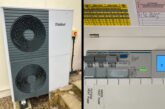
Mike Lawrence, Marketing Manager – Commercial Buildings at Hager, discusses some of the key considerations to be aware of when selecting surge protection devices for your installation.
The protection of expensive and important equipment against transient overvoltages means the inclusion of surge protection devices (SPDs) is a critical aspect of a successful and safe commercial installation.
Following further clarification on the role of SPDs in 2019’s 18th Edition Regulations, electrical designers and contractors need to ensure they fully understand their responsibilities and the potential impact of technical aspects such as device integration into assemblies and subsequent performance.
One of the outcomes of last year’s changes was an increased focus on equipment protection against surge transient voltages. In commercial installations, the new Regulations clarify why and where a surge protection device should be fitted, while stating it is the responsibility of the electrical designer to ensure the installation is compliant.
The Regulations are clear. Protection against transient overvoltages needs to be provided where the consequences caused by overvoltage could:
Result in serious injury, or loss of human life, or
Result in interruption of public services and/or damage to cultural heritage, or
Result in interruption of commercial or industrial activity, or
Affect a large number of co-located individuals
The above accounts for the vast majority of commercial installations, ranging from public buildings and business premises, and require the inclusion of surge protection. In the unlikely event that a non-domestic installation is not covered in the aforementioned four scenarios, then a risk assessment needs to be performed.
Should the outcome of this risk assessment indicate that surge protection devices are needed, its a requirement they are installed. Likewise, if the risk assessment isn’t performed then surge protection devices should be installed.
The 18th Edition of BS7671 has placed a new spotlight on the subject of surge protection in buildings. Today, significant issues connected to areas such as standard conformity, installation variables and potential solutions, are increasingly important considerations for electrical professionals who want to achieve the best and safest installation result.
The link between BS7671 and BS EN 61439
Ensuring conformity of electrical distribution assemblies to BS EN 61439, where third party devices are incorporated into assemblies, creates challenges for manufacturers, panel builders and installers alike. Proving credible evidence that assemblies remain compliant with BS EN 61439 often requires additional testing, or can be achieved by calculation or derivation, where additional devices are added to the assembly. SPDs are not ‘Watt loss’ generating devices, but never-the-less, take up space in the assembly and could affect thermal testing results of the complete assembly.
Installation variables
SPDs are designed to limit overvoltages from surge voltage transients in electrical systems by diverting them to Earth. Section 443 of the Regulations provides guidance for the rated impulse voltages for overvoltage categories and includes further guidance on the type of SPD required to protect equipment.
However, the technical data that indicates the level of potential let through Voltage U(p) that the SPD achieves, is derived by testing the SPD in ideal conditions. Installation variables, which could include the length and diameter of conductors used to connect the SPD to the electrical system, bends in cables, the location of the SPD and effectiveness of Earth conductors, all affect the actual level of protection (Up) value that the electrical system sees, downstream of the SPD.
These installation variables can combine, with the potential for a significantly higher (Up) value and therefore a significantly lower level of protection of sensitive electrical equipment. Poor integration of the SPD can easily result in a measured let through (Up) value that leaves equipment vulnerable to transient overvoltages.
SPD performance testing in assemblies – a new solution from Hager
By measuring the actual (Up) value at the distribution board busbar system, the impact of installation variables can be compared to the published let through Voltage U(p) of the SPD device. Through development trials, using fast transient generators and fast scan oscilloscopes, Hager has re-engineered the integration of the SPD devices, changing the location of the SPD in the distribution board where required and, in some cases, replacing cable connections with solid copper links for Line, Neutral and Earth connections, to achieve enhanced (Up) values as measured at the distribution board.
With a tested level of performance achieved through development testing, specifiers and installers of electrical distribution boards are now able to provide building owners and operators with a greater level of assurance that the SPD designed to protect end equipment from damage has been integrated to achieve the highest level of protection.
Download a copy of Hager’s 18th Edition Surge Protection Flyer here.









